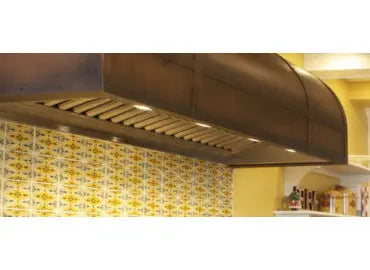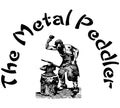
Range hoods - how to choose an exhaust system for your kitchen
Purchasing a range hood can be a costly and confusing business. Not only do you have so many designs to choose from, but what power of fan do you need? What kind of filters? What’s the difference between the metals used, or whether it’s an off-the-shelf unit or custom made?
Fan/ blower
Power: CFM
Blowers are rated by CFM (cubic feet per minute) – that is, how much air they move. The rate of air movement and the requirement is based on the stove top you have. The more heat produced the bigger the blower you need. Check with the manufacturer of your stove for their recommendations as well as your local code requirements. A general guide is: for every 10,000 BTUs your cooktop produces, you need 100 CFM. For a ballpark example, a cooktop producing 90,000 BTUs would need a 900 CFM unit. Keep in mind, if you have very long duct runs to vent outdoors, then you might need to adjust this. Talk to us or your contractor.
You should purchase an adequate size, but don’t go overboard. If you choose a fan much larger than you need, you could end up ventilating your whole house!
Internal or external fan
An internal unit is positioned inside the range hood and pushes the air outside through the duct. An external unit sits outside of the house, on an exterior wall or roof and draws the air out. These are useful for larger fans where noise can become an issue. Note: often external units will require 10” duct and so you must also check if that is a feasible option with the structure of your home. An inline unit is also an option: these sit partway between the hood and the outside exit point--in an attic, for example.
What about recirculating blowers?
We don't offer these with our hoods because all they really do is filter out some of the grease and then put all the air back into the kitchen, removing none of the unpleasant aromas that you might be trying to remove. Some do come with charcoal filters that couple possibly remove some of the smells, but not most of them. Unless you have no other options at all, then vented is the way to go.
Safety features
Consider purchasing a unit with built in heat sensors. These will turn the fan on should excessive heat be detected and draw the heat out of the kitchen. Make sure you also chose a unit that is UL listed and HVI certified.
Make up air. Since first publishing this article, the requirement of make up air has surfaced. Make up air is a method by which, when air is drawn through the hood in a very well insulated house, additional air is added to the home to prevent a vacuum pressure. With very high CFM blowers in some homes, a lot of air being exhausted can cause big issues without this make up air. Be sure to consult with your contractor or check your local Codes. When we supply a range hood, we do have the option of also providing a make up air kit.

Filters
Different companies have different options – from regular mesh filters, baffle filters and stainless steel trays that trap grease. Modern units have filters that are dishwasher safe. Baffle filters give a professional restaurant style look but can be more expensive. What you chose is usually a personal preference on style rather than function.
Metals & construction of range hoods
By far the most common metal used to build range hoods is stainless steel. Increasingly popular are range hoods painted to match your appliances, as well as other metals such as zinc and copper, a more expensive metal but highly sought after by homeowners who want something different and more dramatic in their homes.

Left: Custom copper range hood in Crescent design
Copper also comes in different thicknesses, often measured in gauge or weight. The lower the gauge number, the heavier and thicker the copper. Roofers, for example, commonly use 16oz or 20oz copper (technically called “soft copper”). For our range hoods, we only ever use 48oz copper – much heavier duty & creating a much stronger hood that is far less likely to dent or ding with every day use as well as being less susceptible to surrounding heat. 48oz copper is equivalent to 14 gauge, or 062 in thickness.
With heavy duty copper comes a heavy range hood and so requires a sturdy internal structure and welded seams. Welding copper is a highly skilled and labor intensive job, far more so than welding harder metals such as steel. It provides a completely seamless and much stronger range hood. Although thicker copper is much harder to work with, the final result is most definitely worth it in looks, quality & durability! Your hood should be built to last decades.
Purchasing a custom hood made in the USA not only supports American manufacturers and keeps jobs within the country, it also gives you the reassurances of US-standards in the quality of the materials used, the methods of construction, and also the safety conditions of the workers.
Commercial or custom made vent hoods
Vent or exhaust hoods may vary from $150 to thousands of dollars and, as with most things, what you pay is usually what you get. Low CFM fans and cheaper construction accompany the lower priced units. If you need a big fan for a big range or want a specialty item, be prepared for a higher sticker price.
Clients choose custom & bespoke pieces for a variety of reasons: special requirements, made i the USA, handmade versus machine made, or simply because they want to go back to traditional craftsmanship & embrace true quality craftsmanship at its finest. And for us, custom made is more personal - it's made for you.
© The Metal Peddler, Inc 2007
All right reserved
The post originally appeared at http://themetalpeddler.blogspot.com July 12, 2007 and was updated March 2019.




